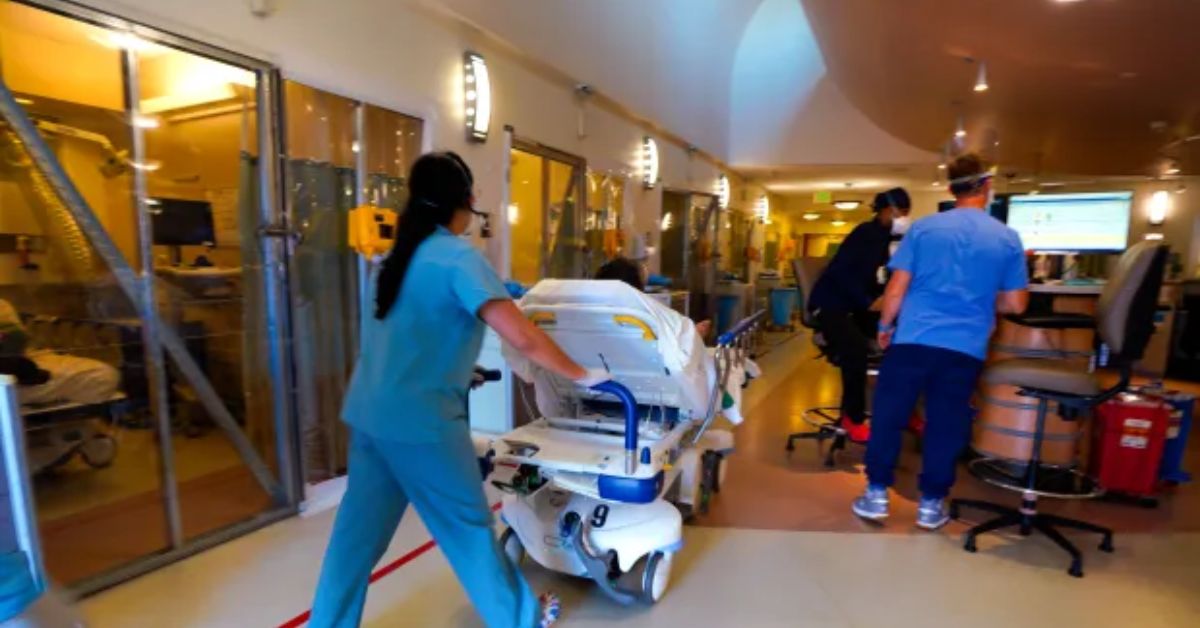Emergency departments (EDs) represent the frontline of healthcare, offering critical and immediate care to patients in urgent need. In California, these departments serve a diverse and growing population, making them essential pillars of the state’s health system. Yet, despite their importance, emergency departments are facing a crisis: overcrowding. The strain on California’s EDs has been worsening over the past decade, driven by rising patient demand, limited inpatient capacity, and workforce challenges.
Among the most significant factors behind this problem are nursing workforce gaps. Nurses are at the centre of emergency care, managing triage, patient monitoring, and rapid response to life-threatening conditions. Without sufficient nursing staff, even the most advanced EDs struggle to deliver safe and timely care. Research has shown a direct link between ED overcrowding, insufficient nursing resources, and increased mortality risk.
This article explores the relationship between ED overcrowding and mortality in California, focusing on how nursing workforce gaps intensify the crisis. We’ll review the state of the nursing workforce, the evidence connecting overcrowding to patient outcomes, and strategies to close these gaps to safeguard lives.
In This Article
Background of Emergency Department Overcrowding
Emergency department overcrowding occurs when demand for emergency services exceeds available capacity. In practical terms, this means patients waiting in hallways, longer triage times, and delays in treatment. In California, the issue is particularly severe due to several key drivers.
First, the state’s population growth and ageing demographics increase the burden on EDs. Older adults are more likely to have chronic illnesses such as heart disease, diabetes, and respiratory conditions, all of which can lead to emergency visits. Second, limited inpatient beds often cause patients to “board” in the ED while waiting for admission, blocking space for new arrivals.
The California Hospital Association reports that ED visits have steadily increased over the past decade, with spikes during flu seasons and public health crises. The COVID-19 pandemic further intensified these challenges, leading to longer wait times and strained resources. Compared nationally, California is among the states most affected by overcrowding, particularly in urban centres like Los Angeles, San Diego, and San Francisco.
Overcrowding is not just an operational issue it directly affects patient safety. When EDs are stretched beyond capacity, critical interventions are delayed, and the risk of preventable harm increases.
The Role of Nurses in Emergency Care
Nurses form the backbone of emergency departments. They are responsible for triage, stabilising patients, monitoring vital signs, administering treatments, and coordinating care across teams. Their presence ensures that patients receive timely and effective interventions.
One of the most important aspects of nursing in emergency care is the nurse-to-patient ratio. Studies consistently show that lower ratios—meaning more nurses per patient—are associated with better outcomes. California is unique in that it enacted AB 394, a law mandating minimum nurse staffing ratios. For example, in emergency departments, the required ratio is 1 nurse for every 4 patients.
However, meeting these ratios is becoming increasingly difficult. Workforce shortages mean that many hospitals operate with stretched staff, sometimes relying on temporary or travelling nurses. When ratios are not maintained, nurses are forced to care for too many patients simultaneously, which compromises safety.
Nursing workforce gaps amplify ED overcrowding by slowing down triage, delaying medication administration, and reducing monitoring frequency. In emergencies, even minutes can mean the difference between survival and loss of life.
Current State of the Nursing Workforce in California
California has the largest pool of registered nurses in the United States, yet the demand for nursing care continues to surpass the available supply. According to the California Board of Registered Nursing, the state is projected to face a shortfall of over 40,000 nurses by 2030 if current trends continue. This gap has significant implications for hospitals, particularly emergency departments (EDs), where timely care can mean the difference between life and death.
1. Vacancies and Turnover
One of the major challenges facing the nursing workforce in California is high vacancy and turnover rates. Hospitals across the state frequently report open nursing positions that remain unfilled for months. Younger nurses, in particular, are more likely to leave positions early due to dissatisfaction, heavy workloads, or better opportunities elsewhere. This revolving door effect leaves healthcare facilities struggling to maintain consistent staffing levels, increasing pressure on the remaining nurses.
2. Burnout and Stress
Nursing is inherently demanding, but emergency nursing is especially stressful. Nurses working in EDs face unpredictable patient volumes, long hours, and the emotional toll of managing life-threatening cases daily. The burnout rate among emergency nurses is alarmingly high, leading many to leave the profession altogether or seek less demanding roles. Burnout not only reduces the number of practicing nurses but also affects the quality of care delivered by those who remain.
3. Geographic Disparities
California’s vast geography creates uneven distribution of nursing staff. Urban centres such as Los Angeles, San Francisco, and San Diego attract the majority of nurses due to better pay, more opportunities, and access to resources. However, this leaves rural and underserved regions struggling with chronic shortages. Rural hospitals often have limited ability to offer competitive salaries, making recruitment and retention even more difficult. These disparities mean that access to timely, high-quality emergency care is not equal across the state.
4. Impact of COVID-19
The COVID-19 pandemic had a profound impact on the nursing workforce. Many experienced nurses retired early due to health risks, while others left the profession after experiencing extreme stress and trauma during the height of the crisis. The pandemic also highlighted the vulnerability of California’s healthcare system, as demand surged beyond capacity and staffing shortages became even more visible. Although the immediate crisis has eased, the long-term effects on the nursing workforce remain significant, with thousands of positions still vacant.
5. A Growing Population, Rising Demand
While California already employs the highest number of registered nurses nationwide, its large and diverse population generates ongoing demand. The ageing population, in particular, is driving higher utilisation of healthcare services. Older adults typically require more frequent and complex medical care, increasing the pressure on emergency departments. As demand rises, the shortage becomes especially critical in high-acuity areas like EDs, where the need for skilled and experienced nurses is non-negotiable.
ED Overcrowding and Mortality Risk: Evidence and Research

There is substantial evidence linking ED overcrowding to increased patient mortality. When departments are over capacity, patients wait longer to be assessed, diagnosed, and treated.
One well-documented phenomenon is “left without being seen” (LWBS). Patients who cannot wait due to long queues sometimes leave before receiving care, leading to untreated conditions that can escalate into life-threatening emergencies.
A 2019 study in Health Affairs highlighted that mortality rates rise significantly in overcrowded EDs, especially among patients with heart attacks, strokes, and sepsis. In California, hospitals experiencing the highest levels of crowding reported longer door-to-needle times for stroke patients and delayed interventions for cardiac emergencies.
The evidence is clear: overcrowding is not just an inconvenience. It directly translates to higher mortality risk, particularly when compounded by inadequate nurse staffing.
Nursing Workforce Gaps and Patient Safety
Nursing shortages directly compromise patient safety in emergency departments.
- Delayed Monitoring: With too many patients assigned to one nurse, vital sign changes may go unnoticed, delaying interventions.
- Medication Errors: High workloads increase the likelihood of mistakes in administering drugs.
- Slower Triage: Insufficient staff extend triage times, delaying care for the sickest patients.
- Weakened Infection Control: Nurses play a key role in maintaining hygiene and infection protocols. Shortages mean lapses are more likely.
Studies show that each additional patient assigned to a nurse increases the risk of mortality by 7%. In California, maintaining safe staffing ratios has been linked to improved survival rates, but when workforce gaps occur, these gains are undermined.
Systemic and Policy Factors Driving Nurse Shortages
California’s nursing workforce gaps are not only the result of individual career choices or hospital-level issues they are rooted in broader systemic and policy challenges. These factors create persistent barriers that prevent the state from training, recruiting, and retaining enough nurses to meet rising demand.
1. Education Pipeline
One of the most pressing challenges is the nursing education pipeline. While interest in nursing careers remains strong, many applicants are turned away from nursing schools due to limited faculty and training capacity. The shortage of qualified nursing educators means fewer students can be admitted each year, slowing the growth of the workforce despite high demand.
2. Economic Challenges
California’s high cost of living creates additional pressure. Hospitals, particularly those in rural or underserved areas, often struggle to offer salaries that are competitive enough to attract and retain staff. Nurses working in these regions face the burden of expensive housing and living costs, making relocation less appealing.
3. Policy Gaps
Workforce planning policies have not kept pace with demographic and healthcare trends. While California has implemented staffing ratio laws to protect patient safety, broader strategies for long-term workforce development remain fragmented. Without coordinated policies, hospitals are left to address shortages on their own, often with limited success.
4. Limited Incentives
Finally, there are few incentives for nurses to work in areas of greatest need. Financial support, professional growth opportunities, or loan forgiveness programs are not widely available, leaving rural and underserved communities chronically short-staffed.
Together, these systemic and policy issues form a cycle where the supply of nurses cannot meet demand. As a result, hospitals remain short-staffed, emergency departments face overcrowding, and patient safety is put at risk. Addressing these root causes is essential for long-term healthcare resilience in California.ing.
Broader Implications of ED Overcrowding
Emergency department (ED) overcrowding is often measured in terms of delayed treatments and higher mortality risk, but the impact extends far beyond direct patient outcomes. When emergency departments operate at or above capacity for long periods, the effects ripple across the entire healthcare system, affecting staff, patients, and public trust. In California, where EDs serve as a critical safety net for underserved and vulnerable populations, these implications are especially profound.
1. Strain on Healthcare Staff
Overcrowding places enormous pressure on healthcare professionals. Nurses, physicians, allied staff, and support workers must care for more patients than is safe or sustainable. This constant stress leads to burnout, fatigue, and high turnover, worsening the workforce crisis. In emergency departments, burnout can also increase the risk of errors, further compromising patient safety.
2. Higher Healthcare Costs
Delayed care in overcrowded EDs often leads to complications that require more intensive treatment. Patients who could have been stabilised with timely intervention may end up needing longer hospital stays, additional procedures, or even intensive care. These avoidable complications drive up healthcare costs, creating a financial burden for both patients and the system. In California’s already expensive healthcare landscape, the economic impact of overcrowding is particularly concerning.
3. Psychological Toll on Patients
For patients, long waits in crowded emergency departments create more than physical risks. Anxiety, fear, and frustration are common experiences when care is delayed. Vulnerable groups such as older adults, low-income patients, or those with chronic conditions often suffer the most. Over time, these negative experiences can erode trust in healthcare providers, leading to reluctance to seek timely care in the future.
4. Public Perception and Trust
Persistent overcrowding also undermines public confidence in the healthcare system. When patients repeatedly encounter packed waiting rooms, long waits, and delayed care, they perceive the system as inadequate. This loss of trust not only affects patient satisfaction but also weakens community support for healthcare initiatives and policies aimed at improving care.
5. California’s Safety-Net Challenge
In California, EDs serve as the frontline for safety-net populations who may lack access to regular primary care. Overcrowding magnifies inequalities, as vulnerable groups are disproportionately affected by delays, stress, and limited resources. Without addressing these systemic pressures, the state risks deepening disparities in health outcomes.
In short, the implications of ED overcrowding reach far beyond hospital walls. It is not just a crisis of capacity but a crisis of confidence, cost, and compassion one that California must urgently address.
Strategies to Address Nursing Gaps and Reduce Mortality Risk
Tackling ED overcrowding requires addressing nursing workforce gaps directly.
Short-Term Strategies
- Hiring Incentives: Offering sign-on bonuses and competitive wages.
- Travel Nurses: Filling immediate gaps with temporary staff.
- Telehealth Support: Using virtual tools to reduce unnecessary ED visits.
Long-Term Solutions
- Expand Nursing Schools: Increasing faculty and student capacity.
- Scholarships and Grants: Encouraging more people to enter the profession.
- Workforce Planning: Statewide strategies to predict and address shortages.
- Technological Innovations: AI triage tools and digital monitoring to ease workload.
- Community Care Models: Strengthening primary and urgent care to reduce ED demand.
By combining immediate interventions with structural reforms, California can address both overcrowding and mortality risk.
Case Studies and Success Models
Some California hospitals have successfully tackled ED crowding through nurse-focused initiatives. For example:
- Hospitals that invested in nurse residency programs improved retention and reduced turnover.
- Facilities using rapid triage protocols led by nurses shortened wait times and improved outcomes.
- States like Massachusetts and Minnesota, with strong workforce planning, report lower ED overcrowding rates and better patient outcomes compared to California.
These models highlight that strategic investment in nursing pays dividends in patient survival and system efficiency.
Must Read:
- Nurse Shortage in California Drives Up Healthcare Costs
- Low Nurse Staffing and Mental Health Outcomes in CA
- Nursing Faculty Shortage & Educational Bottlenecks
Conclusion:
Emergency department overcrowding is a critical issue in California, with direct links to higher mortality risk. The shortage of nurses is a central factor intensifying this crisis. When EDs lack sufficient staff, triage slows, monitoring weakens, and critical interventions are delayed costing lives.
California’s future health depends on bold action: strengthening the nursing workforce through education, incentives, and systemic reforms. By addressing these workforce gaps, the state can reduce ED overcrowding, improve patient outcomes, and restore public trust in healthcare.
Ultimately, investing in nurses is investing in survival. For California, ensuring that every patient has timely access to skilled emergency care could be the difference between life and death.







